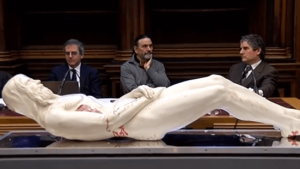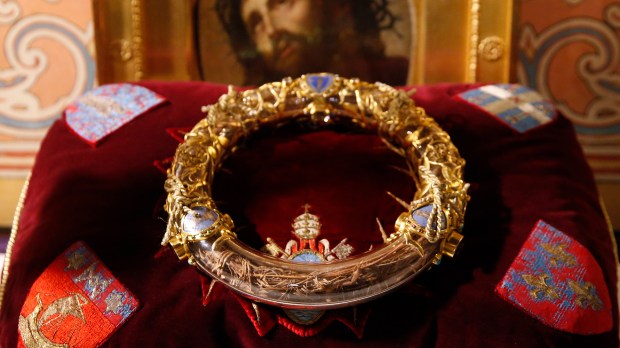Local legends state that there were a handful of local people who knew where the true cross was hidden and had passed down that information to their families over the centuries. One, a man named Judas, felt compelled to tell St. Helena where the relics of the true cross were buried.
In addition to the cross of Christ, it is also believed that St. Helena found the “title of the cross,” upon which was inscribed, “Jesus the Nazarene, King of the Jews.” She also reportedly discovered the nails of the true cross that were driven into the hands and feet of Jesus.
Since the time of St. Helena, there have been numerous other relics of the Passion that have shown up. Are they authentic?
Here is a list of 7 articles on Aleteia that explore these relics and ponder the truth behind them. Click on the titles below for more information.
- Are the relics of Christ and the Apostles authentic?
The mortal remains of Sts. Peter and Paul, pieces of Christ’s cross, the stairs that Jesus climbed during his Passion … Over hundreds and hundreds of years, millions of pilgrims from around the world have visited Rome to pray before these and other relics. But, are they authentic? This question, which has been the focus of significant debates throughout history, is being addressed by the documentary The Footsteps of Jesus in Rome, presented in the Spanish Embassy to the Holy See. The documentary is a 46-minute film that explores, with previously unpublished images, the origin and stories of the numerous relics of Christ and his Apostles located in the Eternal City. - 8 Incredible relics from the Holy Land that St. Helena might have found
Besides the cross, title and nails, tradition claims St. Helena found the crown of thorns that was placed upon the head of Jesus during his Passion and his tunic that was stripped from his body. Not only that, Helena is the one who brought from Jerusalem to Rome the “holy stairs” that led to the palace of Pontius Pilate. Outside of these relics associated with the passion of Jesus, Helena is also credited with bringing back relics of the “holy crib” and even some hay from the manger where Jesus was laid when he was born. - New data questions finding that Shroud of Turin was medieval hoax
In 2017, Casabianca submitted a Freedom of Information request to the British Museum and was allowed to see the data. “Our statistical analysis shows that the 1988 carbon 14 dating was unreliable: the tested samples are obviously heterogeneous, and there is no guarantee that all these samples, taken from one end of the sheet, are representative of the whole fabric. It is therefore impossible to conclude that the shroud of Turin dates from the Middle Ages,” Casabianca explained in an interview with a website called L’Homme Nouveau. Casabianca said his work will help find answers beyond the research of the American chemist Raymond N. Rogers, who debunked the 1988 dating, because he had only the data published by Nature to work with. Rogers maintained that the three Shroud test samples used in 1988 were cut from an outer edge on a piece of the cloth added later as a repair because of frequent handling of the Shroud in public veneration. - Virtually visit the Basilica of Santa Croce in Gerusalemme: See relics of the Passion
The basilica has undergone several renovations. Its current appearance dates back to the 18th century. During the restoration in the 15th century was found the “Titulus Crucis,” the sign placed on the cross of Jesus, with the inscription chosen by Pilate. The text is written in Hebrew, Greek, and Latin characters: “I. NAZARINVS RE[X IVDAEORVM].” Today the relics are kept in a chapel accessed by an uphill corridor, a symbol of the ascent to Calvary. In the reliquary are kept three fragments of the “True Cross,” two thorns from the Crown, a holy nail and the “Titulus Crucis.” Over time, fragments of the grotto of Bethlehem, the Holy Sepulchre and the scourging pillar, the Good Thief’s cross and the phalanx of St. Thomas’ finger have been added. - Could a large ship really be built from all the relics of the True Cross?
Wanting to test the claim and see if it was true that all the relics of the true cross would build a massive ship, a French independent scholar named Charles Rohault de Fleury tracked down every surviving relic and published a scientific study in 1870 entitled Mémoire sur les instruments de la Passion. After calculating the weight of the cross that Jesus would have carried, he estimated that the volume of the cross would have been 10,900 cubic inches. De Fleury then compared that number with the total volume of all the true relics of the cross. He discovered that all the relics in the world amounted only to 240 cubic inches. Surprised by the number, de Fleury multiplied the number by 10 to cover any relics that were destroyed or in private hands. Even after that, 2,400 cubic inches was not even close to the original volume of the cross. - What kind of wood was the Cross of Christ made of?
Perhaps not many people dwell on the issue today, but at various times in the history of Christianity, people have sought to explain where the cross of Christ originated. Some of the legends that have sprung up are imaginative, and often carry spiritual meaning related to salvation history. In 1910, James Charles Wall, a British ecclesiologist, collected some of these legends in his book Relics Of The Passion. “When the world rang with the news that the Holy Cross had been discovered, and everyone was asking for details, according to the working of each individual mind, there arose these questions among others,” he wrote. “Of what wood was it made? Where did it grow? In which locality budded forth that plant …?” - These relics of Jesus’ crown of thorns can be found in Italy
The thorn is said to have been brought to Recco by Fabiano and Giulio Ageno, ship captains returning from the Crusades. It was then placed in a reliquary on an altar in the church. The thorn measures about 1.8 inches long, and is very thin. The feast of the Holy Thorn is celebrated on Easter Monday. However, the reliquary is put on public display on other specific occasions as well.

Read more:
This 3D “carbon copy” of Jesus was created using the Shroud of Turin

